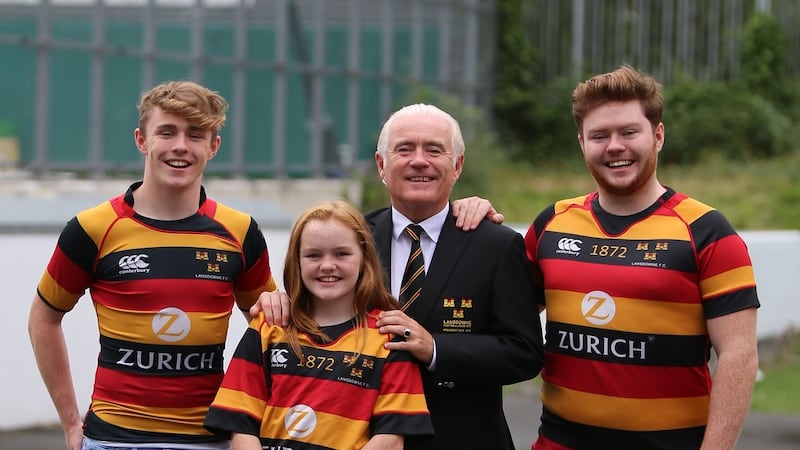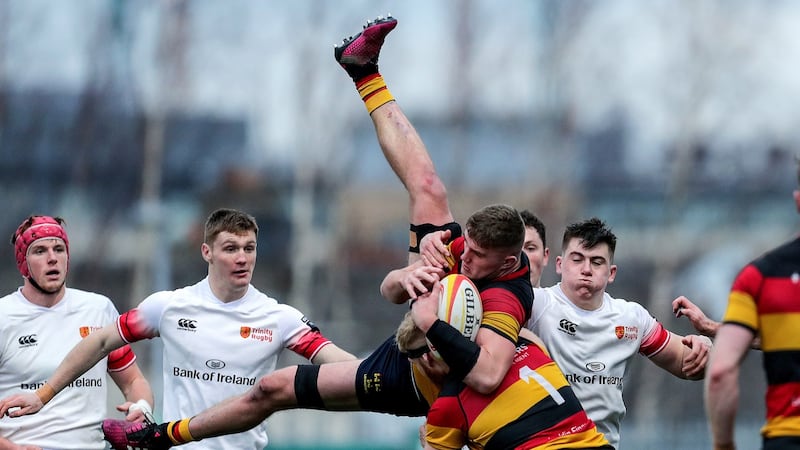Irish rugby has, in many ways, never been in ruder health.
The Ireland team, lest we forget, has just had its best year ever. The Under-20s have just won a Grand Slam. The provinces remain as competitive as ever and, after Leinster’s double last season, again remain in contention in both Europe and the Pro14.
At the top, all is good, if in need of constant tweaking. The IRFU’s investment in high-quality coaching at provincial level has borne fruit, and the game management of the frontline players has largely staved off wealthy French and English clubs.
And the provinces – well, primarily Leinster – have a conveyor belt of talent, akin to the American Football collegiate system.
But, akin to American Football, Irish rugby is heading toward the point where it will be a game for professionals only, with the rest in the stands or munching pizza in front of the TV. The grassroots, in the shape of the club game, are continuously fighting a losing battle, and the IRFU seem not to care a jot.
Last Saturday, Lansdowne hosted Garryowen, their free-wheeling 54-26 victory moving them to second in Division 1A of the All-Ireland League. They host third-placed Clontarf today with the winners to have home advantage for a repeat meeting in the semis, when Cork Con will host Trinity. Lansdowne are thus two games away from their fourth AIL title in seven seasons.
Lansdowne are relatively vibrant but, like every other club, they are swimming against the tide. The way their president Kieran Mulligan sees it, this is a case of “club versus country” rather than the two working together.
Mulligan, from Waterford, was a scrumhalf who played for Waterpark and then Lansdowne, where he only ever played only junior rugby, in the mid 1980s.
Involved in the administrative side of the game on a continual basis since he retired in 2002, Mulligan accepts that an Ireland player’s links to his club were bound to suffer as a consequence of their full-time commitment to their provinces.
“But they need to co-exist, side by side. Right now, all anybody seems to be concerned about is Leinster, Munster, Ulster, Connacht or Ireland. How I would synopsize it is if Ireland win the World Cup and the amateur game dies, then we’ve won nothing and lost everything.”
The AIL’s age profile has long since been getting younger.
“Thirty-five-year-old props are very, very rare nowadays. And it’s a struggle getting the J2s and J3s out,” admits Mulligan whereas, in the mid-80s, come the end of the season when cups were on the line, Lansdowne would have fielded around ten teams.
Non-payment
Mulligan accepts that Lansdowne are fortunate to have many things going for them, not least location. They also benefitted from their deal with the IRFU when the old Lansdowne Road was redeveloped.
There’s also a widespread suspicion amongst other Division 1A clubs that Lansdowne pay their players.
“We don’t pay any players,” states Mulligan categorically.
“I get it in the neck at every game we go to. We do not pay our players, we pay our coaches. On and off the book we don’t pay any of our players. We don’t have fellas doing it behind the scenes. We appealed Regulation 6 (governing the non-payment of club players) because we wanted to create an academy linking in with one of the universities so we could send kids to college but the union refused it and only UCD and Trinity are allowed to do that.

“So we’re up against it,” adds Mulligan, noting how Lansdowne have historically drawn on players from outside Dublin, especially Munster.
“But it’s much harder these days because accommodation in Dublin is so expensive.”
The clubs have been around for a century and a half. Indeed, Lansdowne will be 150 years old in 2022. Like all clubs, they play an important role in their local communities, and they give back too.
Mulligan, making his first, emotive appearance at a pre-match function for six weeks last Saturday due to the recent passing of his wife Tash, was one of the driving forces of this third pre-match, fund-raising lunch.
They did better than expected, raising close to €20,000 on the day, and thus a grand total of €38,000 over the season. The local charities which will be the beneficiaries are the new ARC Cancer Support Centre on the Merrion Road; the RDRD Ringsend & District Response to Drugs; the News Four Community Employment Scheme; the RICC Ringsend & Irishtown Community centre and the St Andrew’s Resource Centre, Pearse Street.
The clubs also play a vital role in the community through their mini-rugby sections, only to then suffer from an increasing disconnect with the elite rugby-playing schools and the provincial set-ups.
“Players who started with clubs but then go on to play first team rugby for their schools should be allowed to retain their club links,” says Mulligan.
“Let’s say a player doesn’t make the Leinster academy or sub academy straight after school, then he might give up rugby. But if he is still in touch with his club the system has that safety net, but the schools forbid them to play for their clubs so they lose that connection for five or six years.”
No sponsor
Because of his own keen interest, and due to his eldest son, James, playing rugby, Mulligan helped form underage sides in Lansdowne from under-13s to under-18s. Last season Lansdowne won the (Under-17) Leinster Premier League and Cup double, with Mulligan’s second son, Hugo, at scrumhalf.
“We had nine different schools represented on that panel. We give them Lansdowne jackets with their initials, and bring them on a tour every year. A few of them will come back this year, and they’re Lansdowne boys now,” says Mulligan proudly. “We’ve been to Portugal, Italy, Spain. Just weekend tours, two or three nights. We fund-raise throughout the season for it and the boys all become mates.”

After school years, a subsequent grounding in the AIL game can also be a vital part of a player’s development and growth.
Of the current Leinster squad, James Ryan, Dave Kearney, Devin Toner, Peter Dooley and Max Deegan all played AIL rugby for Lansdowne. Ditto Dave Heffernan, Paul Boyle, Matt Healy, Tom Daly, Tom Farrell, Cian Kelleher, Conor McKeon and Shane Delahunt in Connacht. Likewise, Jordi Murphy, John Cooney, Marty Moore and Clive Ross in Ulster, and Tadhg Beirne in Munster.
Yet now the running of the club game has reached the stage that Mulligan believes: “The IRFU should have a separate amateur union or wing, to run the club game.”
He cites one example.
“There was no sponsor for the AIL this year,” he says, incredulously. “Ulster Bank stopped last year and then David Nucifora announces in the middle of the summer that they were changing the whole structure of the league, with no consultation.
“I understood that his job is about getting the best out of the professional game, and primarily Ireland and then the provinces. I’ve met him, he’s a nice guy and I’ve no truck with that. But the problem I have is that it seems as if the clubs are completely expendable.”
“Take my home club Waterpark as an example. They built an extension onto their clubhouse, added an all-weather training facility, but the economy changed. The vulture funds ended up with the loan. They were about to take the land from Waterpark three years ago, which would have meant the club going out of existence. So a dozen families or so like mine, and local business people, got together, bought out the loan and then gave the grounds back to the club.”
“But if we hadn’t done that, and it could have been Clonakilty or a club in Donegal, the club was gone. And where was the union?”
As Lansdowne’s president, he’s heard so many of his counterparts say the same things, specifically: “We’re not getting the support of the union.”
Another example is the inaugural Cara Cup currently being played out in Boston. The Connacht A and Ulster A squads have been, and this week the Leinster A and Munster A squads play against the New England Free Jacks either side of playing against each other last Wednesday for a third time this season.
Player drain
After the ending of the British and Irish Cup, featuring A sides from Ireland, Wales, Scotland and England’s Championship, at the end of last season, Nucifora [the IRFU performance director] looked at revamping the AIL.
He proposed a Division 1A, ringfencing two clubs from each province, with no promotion/relegation for the first two years. While it had some merit, akin to turkeys voting for Christmas, this was never going to be accepted democratically by the 50 AIL clubs.

Nucifora instead sanctioned the provincial A squads competing in the Cara Cup, along with the New England Free Jacks, who will compete in the American Major League next season.
This rankles with the clubs on a number of levels. The Leinster and Munster squads have been drawn heavily from the club game, as well as academy players, given their senior squads are competing at the business end of Europe and the Pro14.
Munster have already recalled six of the side that featured last weekend to bolster the senior squad for training, meaning that the team playing the Free Jacks today is densely populated with amateur club players.
This player drain on the clubs for an utterly meaningless competition also clashes with the last two rounds of the sponsor-less All-Ireland League, now in its 29th season, with many of the clubs competing for play-off places or fighting for or against promotion/relegation.
A further affront to the clubs is that the Union are effectively placing club players in the shop window for the American Major League.
As it is, Rugby United New York have Ross Deacon, Marcus Walsh and Mark O’Keeffe, all of whom are ex-Lansdowne; while Cathal Marsh (ex-Trinity and St Mary’s), John Quill (ex-Dolphin), Dylan Fawsitt (ex-St Mary’s) and Will Leonard (ex-Shannon) are all in the New York squad, and Ben Mitchell, ex-UCC, is captaining Austin.
The Union reportedly received €250,000 for their participation in the Cara Cup. The former Ireland captain and team manager Donal Lenihan put it thus in The Irish Examiner on Wednesday: “As for the clubs, all they got from rugby headquarters was a giant two fingers.”
As Lenihan also observed, integrating academy/developing professionals into the club structure more would enable them play more games than at present. “Some play less than 10 a year,” he noted.
Big part
Take the three Lansdowne players in this week’s Leinster A squad. Oisín Dowling, who started nine of ten AIL games last season, has been restricted to six this season. Along with six for Leinster A, this has made for the grand total of 12 games this season, five of them off the bench.
Ronan Kelleher has been restricted to seven games for Lansdowne, eight for Leinster A and one for Leinster, thus playing 16 games this season.
Their third squad member, Brian O’Donnell, had been a big part of Lansdowne’s Under-20s but, due to the Cara Cup, he will miss their Fraser McMullan All-Ireland Cup semi-final.
“This is what kills us,” says Mulligan.
“I’m not knocking the Union for the professional game. It’s the way it is. And they’ve a better model than most Unions in the world. But as soon as the B&I Cup went, they tinkered with the AIL, never talked to us, then talked to us and put it on hold. Like everything in life, you’ve got to work with people.”
But the overriding belief throughout the Irish club game is that, rather than working with them, the IRFU are working against them.



















